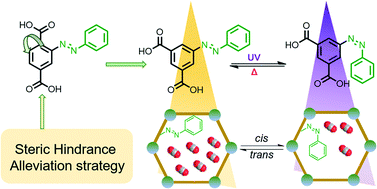A steric hindrance alleviation strategy to enhance the photo-switching efficiency of azobenzene functionalized metal–organic frameworks toward tailorable carbon dioxide capture†
Abstract
Photo-switching metal–organic frameworks are widely reported for low energy CO2 capture and release. However, owing to the steric hindrance caused by dense packing of MOF solids, the photo-switching efficiency was still severely restricted. Such an issue then further causes low CO2 switching capacity and poor regeneration of MOF adsorbents. Herein, we present a strategy to tailor the photo-switching efficiency of azobenzene functionalized MOFs via a steric hindrance alleviation approach. An azobenzene-containing Zn based MOF, U-mazo, was designed to decrease the steric hindrance of azo benzene pendants in U-pazo (PCN-123). For comparison, two MOFs without azobenzene, IRMOF-3 and CMOF-2, were also fabricated. Results suggested that compared to U-pazo, the cis isomer content in U-mazo increased by 50% upon UV light irradiation at 365 ± 10 nm, which contributed to about 34% enhancement of CO2 switching efficiency. Density functional theory calculations further explained that the optimized switching efficiency of U-mazo resulted from the lower energy cost for trans/cis isomerization of azo benzene pendants. Thereby, a promising strategy for optimizing the switching efficiency of the present photoresponsive MOF is explored and verified, and the structural steric hindrance of photoswitching units plays an important role in isomerization of azobenzene-containing MOFs.



 Please wait while we load your content...
Please wait while we load your content...